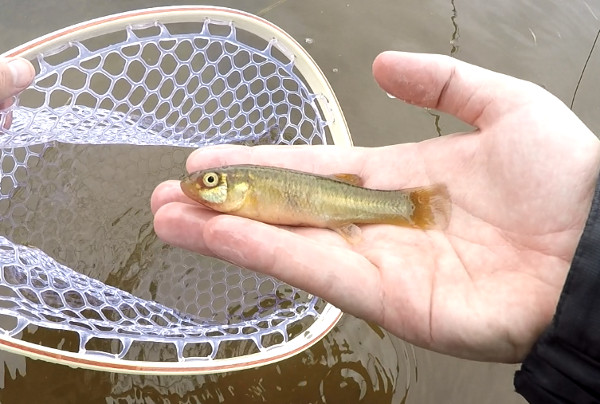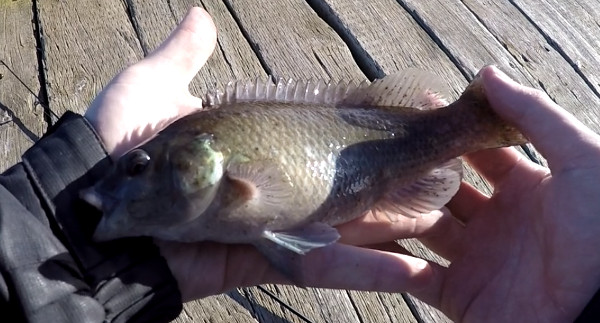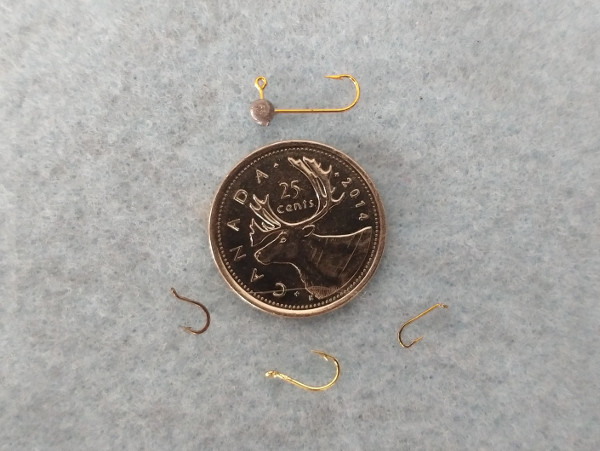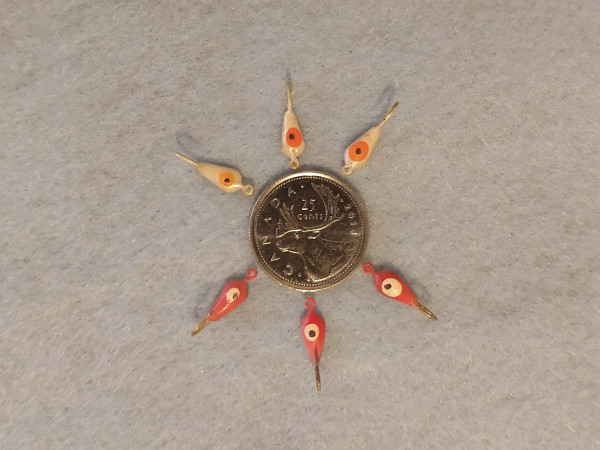The goal in micro fishing is to catch small, often overlooked species of fish. It’s a fun hobby since you get to see and catch fish that go unnoticed by many anglers. There’s also a large variety of fish species the micro angler can target.
 The gear used in micro fishing is much smaller than gear used in most traditional fishing. Let me go through what equipment and techniques are needed to be a successful micro angler.
The gear used in micro fishing is much smaller than gear used in most traditional fishing. Let me go through what equipment and techniques are needed to be a successful micro angler.
The small nature of the equipment and tackle used in micro fishing makes use of fly fishing gear very effective. I go over some of my techniques, equipment, and flies used for micro fishing here.
This post uses amazon affiliate links. I receive commission from any sales at no additional cost to yourself.
Rod and Reels.
Ultra Light Weight Spinning Rod
An ultra light spinning rod that’s typically used for fishing small trout, panfish, and other modest sport fish works perfectly for micro fishing. You won’t need a very big reel, as you don’t need very much fishing line spooled onto it. Nothing you catch is going to be pulling line off your reel, and the fishing line you do use should be as lightweight as possible.
You won’t need to cast very far, as alot of micro fishing happens quite close to the shoreline. This is because these small species of fish tend to be less skittish of anglers than their more-often-targeted sport fish cousins. Smaller species of fish are also more likely to hug the shore line to seek shelter from larger predatory fish.
Another advantage of going with a regular spinning rod is that it’s multi purpose. You can use it for catching larger species of fish in addition to micro fish.
2PC Shinmano Spin Combo (Amazon Link) can be bought here. This rod an reel combo is perfect for the micro angler. It casts lightweight lures and terminal tackle very well, and is a good quality rod and reel at a decent price. When I’m not using a fly rod, this is my rod and reel setup I use when micro fishing.

Pen Rod
When I first heard about the mini pen rod, I dismissed it as just a gimmick… It’s not exactly a rod you want to fight a fish with for any amount of time with. When I rediscovered these rods months later, I realised they are a great option for the micro angler.
Small and compact, they are easier to store than traditional fishing rods. The pen portion of the setup protects the rod while it’s broken down. This makes it much easier to transport, especially if you’re on foot. This makes it a great rod choice for the urban angler that may not have a car to store their equipment in near the fishing hole.
Mini Pen Fishing Rod + Reel (Amazon Link) Can be bought here.
Ice Fishing Rod
Ice fishing rods are another good choice for micro fishing. They are small and compact, and handle light line and small lures well. I will say that they don’t cast very well at all (but they’re not meant to). Ice fishing rods are best used when vertically fishing, such as off of docks, bridges, wharves, or (unsurprisingly) while ice fishing.
An ice fishing rod is a good choice because; like the ultra light spinning rod mentioned above, it can be used for more than just micro fishing. I keep my ice fishing rod in my car in the summer as a back up rod. It works well when we go to the dock and fish. The fish are right under the dock so there’s no need to cast.
Ugly Stik Ice Fishing Reel & Rod Combo (Amazon Link) Can be bought here.
Hooks
 Pictured above are some of the smallest hooks I currently have. At the top is the smallest jig I’ve found on the market, wapsi jighead in size 1/124. On the lower left is a size 16 egg hook. The lower center is a standard salmon egg hook sized 12, and the lower right is a size 20 dry fly hook used for fly tying. Hooks do come smaller than these, these are just what I happen to have with me at the moment of writing.
Pictured above are some of the smallest hooks I currently have. At the top is the smallest jig I’ve found on the market, wapsi jighead in size 1/124. On the lower left is a size 16 egg hook. The lower center is a standard salmon egg hook sized 12, and the lower right is a size 20 dry fly hook used for fly tying. Hooks do come smaller than these, these are just what I happen to have with me at the moment of writing.
When selecting a micro fishing hook, small is the name of the game. Some micro species are not so small (or they’re small but have relativity large mouths) that they require speciality hooks. For these species you can often get away with standard trout or panfish bait holder hooks.
Other species do require speciality hooks though. Either the fish are extremely small, they have a small mouth for their size, or a combination of the two. In these cases you’re going to want to go as small as possible.
Ice fishing has some very small hooks available. you can buy tiny ice fishing hooks that can hold bait just fine.
Egg hooks also tend to be on the small side, as in many cases are intended to be completely encased by an egg used as bait. They are also worth checking out if you’re shopping around for small hooks.
Fly tying also has some very small hooks available. you can buy bare hooks intended for use with fly tying, and just use them as you would any other hook.
Gamakatsu Barbless Hooks Pack Of 25 (Amazon Link) Can be bought here. These are very small, very effective hooks produced specifically for catching small fish. They are smaller than any of the hooks pictured above. I’ve used them before with great success. The hook eyes are quite small, so be sure to use thin fishing line with them.
Baits and Lures
Micro fishing gear includes more than just hooks. There are some baits that are more effective with micro fishing than regular fishing, and even some lures that you can use to catch small species of fish.
Micro Fishing Bait
Waxies (wax worms) are a well known and commonly used bait for sunfish. They work for other small species of fish as well. If you are fishing exceptionally small fish, you may need to cut the wax worm into smaller pieces to fit on the hook. Regular earth worms can also be cut up this way as well.
Another trick is to actually use a bit of cotton off a cotton ball. Just take a small piece off and twist it onto the hook. It mimics a fly used in fly fishing. The little fibres can imitate legs on a bug or a collection of small worms.
Other baits to try include:
- Small pieces of corn kernels
- Hotdog pieces
- Peas
- Cooked rice grain (from leftovers, please don’t boil a single grain of rice for bait)
- Random insects you find on the riverbank or under river rocks.
- Meal worms (can be bought at pet store). These cut up nice.
- Crickets (can also be bought at pet store). You can get pinhead crickets, which are the smaller ones. Be mindful that fish can quite easily steal these off the hook, they are very effective though.
- Soft plastic artificial baits. Berkley’s trout worms work well, and cut up nicely into smaller pieces. Any power bait by Berkley cut into small pieces will work actually.
Berkley’s Gulp! Trout Worm (Amazon Link) Can be bought here.
Micro Fishing Lures
Most fishing lures are going to be far to large to be effective at microfishing. That being said, there are a handful of lures available that are very effective at targeting small fish
Jigs are by far my favourite way to microfish with a spinning rod. Bucktail, marabou, feathered, and bare jigheads tipped with soft plastic lures are all effective. There’s a large number of jigs that will work, but I recommend the mini trout magnet.
Trout Magnet Mini Kit – 70 Grub Bodies 15 Hooks (Amazon Link) Can be bought here.

The ice fishing scene also has some very small lures available. The jigs used in ice fishing are much smaller than those used in the spring, summer and fall. The crystal clear and still water that is often under ice results in picky fish, and these small lures help entices these selective fish to bite. On the flip side, this also means ice fishing jigs are great for micro fishing as well.
Panfish Assorted Jigs 16 Piece (Amazon Link) Can be bought here. This is a good value for the amount of jigs you get.
Flies
Flies used in fly fishing can also be used with a spinning rod to great effect. The smallest flies are much smaller than even the smallest lures on the market, and is what you want to use if you are targeting the smallest species of fish.
You’re typically going to want to use whats called wet flies (nymph and streamers) for micro fishing. These are flies that are intended to be fished below the surface rather than float.
You can use flies with spinning rod with several different set ups. The easiest setup is to use a trout float rig, with a bobber and split shot like shown in this post. Instead of attaching a hook and soft plastic to the bottom of the rig, attach a wet fly instead. You can also fish the smaller jigs mentioned earlier this way.
Like I mentioned earlier in the post, click here if you’re interested in learning about micro fishing with a fly rod.
Other Equipment
Fishing Line
Fishing line choice doesn’t matter a whole lot, a micro fish is not going to snap your line. The main consideration is to keep the fishing line very light weight. You’re going to be casting lightweight terminal tackle, and lighter line will help with casting.
Another reason to stick with light weight line is that many of the lures and hooks you’ll be using have small hook eyes, and larger line may not fit through it.
It’s also not necessary to have a ton of line spooled to the reel. You won’t need to cast long distances in most situations (alot of micro fishing involves sight fishing), and you also won’t be hooking into any fish that’s going to pull line off the reel.
Trout S.O.S. Line Spool 2-Pound Test (Amazon Link) Can be bought here. This is an ideal choice for fishing really small lures. It’s created by the same company that makes the trout magnet.
Bobbers and Floats
Bobbers both add weight to the line (improving casting distance), and help with the presentation of the bait/lure. Position the bobber or float up from the hook, so the hook floats a few inches above the bottom of the river, pond, lake, or estuary your fishing.
Traditional red and white circular bobbers can work just fine, but I find the balsa wood floats a bit more sensitive. It’s a bit easier to see movement on the balsa wood bobbers than the regular circular floats.
5Pcs Balsa Wood Float (Amazon Link) Can be bought here.
Sinkers and Weights
Split shot and other weights are another way to add weight and improve casting. The best weights to use micro fishing would be split shot positioned an inch or so above the hook. These can be used in conjunction with bobbers (using the trout rig mentioned earlier), just make sure you don’t add more weight than the bobber can support.
If using just the weights and terminal tackle (no bobber), split shot is still the way to go. It’s often required to sight fish when fishing this way, as it’s hard to know how the bait is being presented with this rig without seeing it, unless you just let it sit on the river bed (which is not an effective fishing method most of the time, although there are exceptions).
Split Shot Pro Pack (Amazon Link) Can be bought here. This pack has a good variety of sizes. These are lead free, which is important environmentally as well as legally in many fisheries. Since they’re made of tin, they’re also not as heavy for their size, which is perfect for micro fishing as you don’t want them to sink your float or bobber.

Split shot weight (1-2$): The smallest split shot you can find. I used to use the smallest my local Walmart had in stick which cost 2$ for 80. I have since upgraded to the weights that weight 0. and cost about $2 for 300 from my tackle shop.